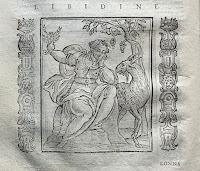 The use of emblems was popular during the Baroque time period in Italy and Europe in general, serving as a guide and source of inspiration for artists, poets, and sculptors when they were looking to creatively represent virtues, ideas, or even animals.
The use of emblems was popular during the Baroque time period in Italy and Europe in general, serving as a guide and source of inspiration for artists, poets, and sculptors when they were looking to creatively represent virtues, ideas, or even animals.Cesare Ripa’s Noua Iconologia, printed in 1618, takes an encyclopedia-like format, alphabetically categorizing his emblems in multiple sections: Main Images (in 3 parts), More Notable Things, Animals, Colors and Metals, Gestures and the Human Body, Artificial Objects, Fish, and Plants. With each emblem description, Ripa also includes allegorical interpretations and references famous philosophers and writers of the time, whose interpretations of a particular object or virtue influenced his depiction of it.
Take the examples of Lust (Libidine) and Chastity (Castità). Ripa writes that the woman that symbolizes
 Chastity in his emblem dresses in white to represent “the purity of the spirit, which maintains this virtue” (“Vestesi questa donna di bianco per rappresentare la purità dell'animo, che mantiene questa virtù.” (77).) and we see an association of colors with the value of chastity, but even more importantly, there is a suggestion that chastity leads to strength and truthfulness of character, as though someone who isn’t chaste is deceitful. Similarly, the emblem of Lust uses a particularly large amount of animal imagery, from beaks to panthers, all of which Ripa says symbolize lust, whose beauty “devours time, money, fame, body, and soul and spits it out becoming a slave to sin and the devil” (“Il che molto è simile alla Libidine, la quale con la bellezza ci lusinga, e tira, poi ci divora, perché ci consuma il tempo, il dannaro, la fama, il corpo, e l'anima istessa ci macchia, e ci avvilisce, facendola serva del peccato, e del demonio.” (312)). This, therefore, adds an element not just of deception, but of monstrosity and of sin, bringing in a religious element as well. Lust, according to Ripa, derives in women not even solely on a sexual level but also on the pursuit of fame and money.
Chastity in his emblem dresses in white to represent “the purity of the spirit, which maintains this virtue” (“Vestesi questa donna di bianco per rappresentare la purità dell'animo, che mantiene questa virtù.” (77).) and we see an association of colors with the value of chastity, but even more importantly, there is a suggestion that chastity leads to strength and truthfulness of character, as though someone who isn’t chaste is deceitful. Similarly, the emblem of Lust uses a particularly large amount of animal imagery, from beaks to panthers, all of which Ripa says symbolize lust, whose beauty “devours time, money, fame, body, and soul and spits it out becoming a slave to sin and the devil” (“Il che molto è simile alla Libidine, la quale con la bellezza ci lusinga, e tira, poi ci divora, perché ci consuma il tempo, il dannaro, la fama, il corpo, e l'anima istessa ci macchia, e ci avvilisce, facendola serva del peccato, e del demonio.” (312)). This, therefore, adds an element not just of deception, but of monstrosity and of sin, bringing in a religious element as well. Lust, according to Ripa, derives in women not even solely on a sexual level but also on the pursuit of fame and money.All of this is to say that the use of emblems both had an impact on the time period’s interpretations of virtues, people, and things in the moment, as well as a longer lasting impact when the allegorical interpretation of these virtues are still seen in the present day depictions of values and morality.
To explore the woodcuts of Lust, Chastity, and many more, come to Special Collections and ask to see Rare N7740.R52 1618.
This post was originally written by Diana Alvarado '22 for Nancy Canepa's Italian 23 class, "17th and 18th Century Italian Literature".
No comments :
Post a Comment